User:Toad is Free!/Sandbox: Difference between revisions
(→Nintendo Entertainment System: Add Games) |
(Add Games) |
||
| Line 11: | Line 11: | ||
!width=15% style="background-color: #e0e0e0;"|Release Date | !width=15% style="background-color: #e0e0e0;"|Release Date | ||
|- | |- | ||
!colspan="3" style="font-size:125%;text-align:left;background-color: #00FF00;"|''[[Donkey Kong]]'' | !colspan="3" style="font-size:125%;text-align:left;background-color: #00FF00;"|''[[Donkey Kong (game)|Donkey Kong]]'' | ||
|- | |- | ||
|align="center"|[[File:Donkey Kong NES Cover.png|150px]] | |align="center"|[[File:Donkey Kong NES Cover.png|150px]] | ||
| Line 17: | Line 17: | ||
|{{release|Japan|July 15, 1983|USA|June 15, 1986|Europe|October 15, 1986}} | |{{release|Japan|July 15, 1983|USA|June 15, 1986|Europe|October 15, 1986}} | ||
|- | |- | ||
!colspan="3" style="font-size:125%;text-align:left;background-color: #00FF00;"|''[[Donkey Kong Jr.]]'' | !colspan="3" style="font-size:125%;text-align:left;background-color: #00FF00;"|''[[Donkey Kong Jr. (game)|Donkey Kong Jr.]]'' | ||
|- | |- | ||
|align="center"|[[File:Donkey Kong Jr NES Cover.png|150px]] | |align="center"|[[File:Donkey Kong Jr NES Cover.png|150px]] | ||
| Line 111: | Line 111: | ||
!colspan="3" style="font-size:125%;text-align:left"|''[[Nintendo World Championships 1990]]'' | !colspan="3" style="font-size:125%;text-align:left"|''[[Nintendo World Championships 1990]]'' | ||
|- | |- | ||
|align="center"|[[File:Standard Cartridge - Nintendo World Championship.jpg|150px]] | |align="center"|[[File:Standard Cartridge - Nintendo World Championship.jpg|150px|Game cartridge, cover image not available]] | ||
|The [[Nintendo Entertainment System|NES]] cartridge serves as the primary competition in the 1990 Nintendo World Championship. The cartridge has a combination of ''[[Super Mario Bros.]]'', ''Rad Racer'', and ''Tetris''. The timer is set for 6 minutes and 21 seconds. Each game is modified for the contest, for example, ''Super Mario Bros.'' has been modified to make the game start with 99 lives instead of just 3. | |The [[Nintendo Entertainment System|NES]] cartridge serves as the primary competition in the 1990 Nintendo World Championship. The cartridge has a combination of ''[[Super Mario Bros.]]'', ''Rad Racer'', and ''Tetris''. The timer is set for 6 minutes and 21 seconds. Each game is modified for the contest, for example, ''Super Mario Bros.'' has been modified to make the game start with 99 lives instead of just 3. | ||
|{{release|USA|October 10, 1990}} | |{{release|USA|October 10, 1990}} | ||
| Line 117: | Line 117: | ||
!colspan="3" style="font-size:125%;text-align:left"|''[[Nintendo Campus Challenge]]'' | !colspan="3" style="font-size:125%;text-align:left"|''[[Nintendo Campus Challenge]]'' | ||
|- | |- | ||
|align="center"|[[File:Nintendo Campus Challenge 1991 cartridge.jpg|150px]] | |align="center"|[[File:Nintendo Campus Challenge 1991 cartridge.jpg|150px|Game cartridge, cover image not available]] | ||
| | | | ||
|{{release|USA|1991}} | |{{release|USA|1991}} | ||
| Line 224: | Line 224: | ||
|''Yume Kōjō: Doki Doki Panic'' started development as a vertically scrolling ''Super Mario Bros.''-style game, eventually gaining horizontal scrolling as well to be more similar. Due to a licensing agreement with {{wp|Fuji TV|Fuji Television}}, it starred a family of Arabian characters owned by the network. This game would go on to become the western ''[[Super Mario Bros. 2]]'', with the Arabian characters replaced with Mario and friends, though other characters (namely enemies and bosses) remaining; many would become recurring to the series. | |''Yume Kōjō: Doki Doki Panic'' started development as a vertically scrolling ''Super Mario Bros.''-style game, eventually gaining horizontal scrolling as well to be more similar. Due to a licensing agreement with {{wp|Fuji TV|Fuji Television}}, it starred a family of Arabian characters owned by the network. This game would go on to become the western ''[[Super Mario Bros. 2]]'', with the Arabian characters replaced with Mario and friends, though other characters (namely enemies and bosses) remaining; many would become recurring to the series. | ||
|{{release|Japan|July 10, 1987}} | |{{release|Japan|July 10, 1987}} | ||
|- | |||
!colspan="3" style="font-size:125%;text-align:left"|''[[Family Computer Golf: U.S. Course|Family Computer Golf: Prize Card]]'' | |||
|- | |||
|align="center"| | |||
| | |||
|{{release|Japan|September 1987}} | |||
|- | |||
!colspan="3" style="font-size:125%;text-align:left"|''[[Famicom Grand Prix: F1 Race]]'' | |||
|- | |||
|align="center"|[[File:F1Race.png|150px]] | |||
| | |||
|{{release|Japan|October 30, 1987}} | |||
|- | |||
!colspan="3" style="font-size:125%;text-align:left;background-color: #00FF00;"|''[[Donkey Kong (game)|Donkey Kong]]'' | |||
|- | |||
|align="center"| | |||
|In [[List of games by date#1981|1981]], Nintendo had their first blockbuster release with [[Shigeru Miyamoto]]'s creation - ''Donkey Kong''. Originally released in the arcades, ''Donkey Kong'' became a very popular game amongst gamers, eventually spawning many remakes and ports. In this game, [[Donkey Kong]] was the antagonist who kidnapped [[Mario]]'s girlfriend Lady (later renamed [[Pauline]]). It was later ported to the many home systems including the Atari 2600, the ColecoVision and the Nintendo Entertainment System. This is a simple platformer, where the player must control Mario while jumping and avoiding obstacles and making it to Donkey Kong. | |||
|{{release|Japan|April 8, 1988}} | |||
|- | |||
!colspan="3" style="font-size:125%;text-align:left"|''[[Famicom Grand Prix II: 3D Hot Rally]]'' | |||
|- | |||
|align="center"|[[File:HotRally.png|150px]] | |||
| | |||
|{{release|Japan|April 14, 1988}} | |||
|- | |||
!colspan="3" style="font-size:125%;text-align:left;background-color: #00FF00;"|''[[Donkey Kong Jr. (game)|Donkey Kong Jr.]]'' | |||
|- | |||
|align="center"| | |||
|In 1982, another arcade game was created, ''Donkey Kong Jr.'' This time, the roles were reversed. Mario was the villain, and DK was a damsel in distress. Here, [[Donkey Kong Jr.]], Donkey Kong's son, had to save his kidnapped father from Mario. The gameplay is the same as the original Donkey Kong; Donkey Kong Jr. must avoid traps set off by Mario to save Donkey Kong by jumping and simply avoiding them. | |||
|{{release|Japan|July 19, 1988}} | |||
|- | |||
!colspan="3" style="font-size:125%;text-align:left"|''[[Kaettekita Mario Bros.]]'' | |||
|- | |||
|align="center"|[[File:Kaettekita Mario Bros. possible boxart.jpg|150px]] | |||
|'''''Kaettekita Mario Bros.''''' is a Japan-only game for the [[Family Computer Disk System]], being mostly a more graphically accurate port of the original arcade game than the 1983 [[Family Computer]] and [[Nintendo Entertainment System]] port. However, it also has new features, such as the ability to change direction mid-[[jump]] and a slot machine [[minigame]]. Many of its graphical enhancements were used in a 1993 European NES port of ''Mario Bros.'' | |||
|{{release|Japan|November 30, 1988}} | |||
|- | |||
!colspan="3" style="font-size:125%;text-align:left;background-color: #00FF00;"|''[[Wrecking Crew]]'' | |||
|- | |||
|align="center"|[[File:WC Disk.jpg|150px|Game disk, cover image not available]] | |||
|'''''Wrecking Crew''''' is a home variation of ''VS. Wrecking Crew'', being more puzzle-oriented and based around single-player gameplay. Unlike in the previous game, the [[hammer]]-wielding CPU-controlled opponent is the brothers' cantankerous boss, [[Foreman Spike]]. This is the first ''Mario'' game to feature scrolling, albeit vertical scrolling. | |||
|{{release|Japan|February 3, 1989}} | |||
|- | |||
!colspan="3" style="font-size:125%;text-align:left;background-color: #00FF00;"|''[[Pinball (game)|Pinball]]'' | |||
|- | |||
|align="center"|[[File:PinballJpDiskSystem.png|150px|Game disk, cover image not available]] | |||
| | |||
|{{release|Japan|May 31, 1989}} | |||
|- | |- | ||
|} | |} | ||
Revision as of 01:45, May 24, 2022
This is a list of games within the Mario franchise and all related series, organized by system with pictures. The games are arranged by original release date. Upcoming games are highlighted in gold. Port games are highlighted in green.
Nintendo Consoles
Nintendo Entertainment System
| Title | ||
|---|---|---|
| Cover | Synopsis | Release Date |
| Donkey Kong | ||
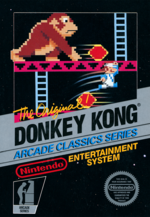
|
In 1981, Nintendo had their first blockbuster release with Shigeru Miyamoto's creation - Donkey Kong. Originally released in the arcades, Donkey Kong became a very popular game amongst gamers, eventually spawning many remakes and ports. In this game, Donkey Kong was the antagonist who kidnapped Mario's girlfriend Lady (later renamed Pauline). It was later ported to the many home systems including the Atari 2600, the ColecoVision and the Nintendo Entertainment System. This is a simple platformer, where the player must control Mario while jumping and avoiding obstacles and making it to Donkey Kong. | Template:Release |
| Donkey Kong Jr. | ||
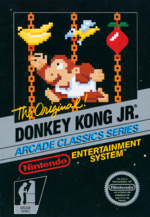
|
The following year, another arcade game was created, Donkey Kong Jr. This time, the roles were reversed. Mario was the villain, and DK was a damsel in distress. Here, Donkey Kong Jr., Donkey Kong's son, had to save his kidnapped father from Mario. The gameplay is the same as the original Donkey Kong; Donkey Kong Jr. must avoid traps set off by Mario to save Donkey Kong by jumping and simply avoiding them. | Template:Release |
| Mario Bros. | ||
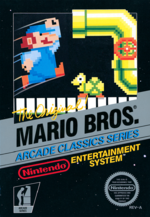
|
Mario Bros. is the second arcade game starring Mario as a protagonist, coming after Donkey Kong. The game's main attraction was featuring cooperative two-player functionality with Mario's recently introduced brother, Luigi. The two are in a sewer, battling various enemies leaking from the plumbing, bashing the floors underneath them to stun them before kicking them away. Many aspects from this game recur in later Mario franchise games, notably coins, pipes, POW Blocks, and enemy turtles. The game has been ported innumerable times to various systems. | Template:Release |
| Donkey Kong Jr. + Jr. Sansū Lesson | ||
| Donkey Kong Jr. + Jr. Sansū Lesson was released exclusively as the pack-in game for the Sharp C1 Famicom TV, a combined Family Computer and television unit in Japan. It is a compilation of the games Donkey Kong Jr. and Donkey Kong Jr. Math. The game is not exactly a combination, but rather a "platter" of the two Donkey Kong-related games. It combines half of the 1- and 2-Player game modes from Donkey Kong Jr. and the +-×÷ Exercise mode from Donkey Kong Jr. Math. The latter is from the prototype version as Donkey Kong Jr. Math was still in development upon this game's release. | Template:Release | |
| Donkey Kong Jr. Math | ||
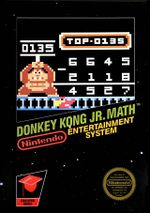
|
Donkey Kong Jr. Math was Donkey Kong Jr.'s second game, an edutainment title released in 1983 for the NES. Donkey Kong will hold up a sign, and Donkey Kong Jr. must find the numbers and math sign to get to that number to get a point. | Template:Release |
| Pinball | ||
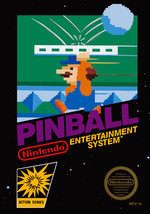
|
Template:Release | |
| Golf | ||
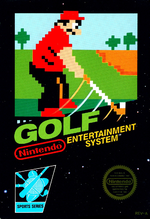
|
This game is much older and less common than the next golf title for the NES, NES Open Tournament Golf, but it has been ported to more systems including the America-only Nintendo PlayChoice-10 and the Game Boy. Mario is the only playable character in the game, appearing in blue pants and a white shirt. Player 2 controls a palette-swap that wears black pants and a red shirt. A version known as VS. Golf was later released for the VS. System. | Template:Release |
| Donkey Kong 3 | ||
| File:DK3 NES Box Art.jpg | Donkey Kong 3 was the third installment of the Donkey Kong series, where Stanley fought Donkey Kong. This game differed from its predecessors in that it is a shooter/platformer hybrid and did not include Mario as a character. | Template:Release |
| Family BASIC V3 | ||
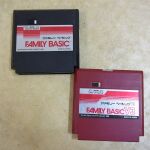
|
Template:Release | |
| Wrecking Crew | ||
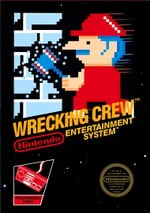
|
Wrecking Crew is a home variation of VS. Wrecking Crew, being more puzzle-oriented and based around single-player gameplay. Unlike in the previous game, the hammer-wielding CPU-controlled opponent is the brothers' cantankerous boss, Foreman Spike. This is the first Mario game to feature scrolling, albeit vertical scrolling. | Template:Release |
| Super Mario Bros. | ||
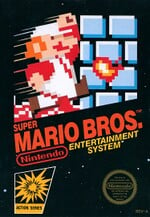
|
On September 13, 1985, Mario starred in his very first game on a home console, Super Mario Bros.. Mario, and his brother Luigi, had to set out on a massive adventure across the Mushroom Kingdom to rescue Princess Toadstool and the Mushroom Retainers from the evil King Bowser. After traversing through eight massive worlds, filled with enemies, the brothers eventually reached Bowser's Castle, finally rescuing Princess Toadstool. Super Mario Bros. was the best-selling video game for the NES in 1999,[1] and, until being surpassed by Wii Sports in 2009, the best-selling video game of all time. Super Mario Bros. also had a major part in both the takeoff of the NES and the revival of the American video game industry after the crash in 1983. The game earned Mario a permanent position as Nintendo's mascot, and triggered a massive boom in the video game industry that still continues today. | Template:Release |
| Donkey Kong Classics | ||
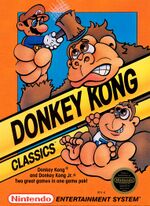
|
Donkey Kong Classics is a video game collection of the Donkey Kong series, consisting of the games Donkey Kong and Donkey Kong Jr.. This compilation is for the Nintendo Entertainment System, which was developed by Nintendo EAD. | Template:Release |
| Super Mario Bros. 2 | ||
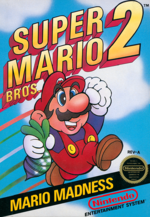
|
Owing to the Western branches of Nintendo feeling that the Japanese Super Mario Bros. 2 was too similar to the first game and too difficult for American players, they instead chose to port the Japanese game Yume Kōjō: Doki Doki Panic and release it as Super Mario Bros. 2 in their markets for the NES. New species first appear in this game, including Albatoss and Shy Guys, and it introduces Wart and Birdo. Super Mario Bros. 2 is also the first game to feature four distinctly playable characters, as Mario, Luigi, Princess Toadstool, and Toad had to save the dream world of Subcon from Wart. After fighting their way through seven strange worlds, they eventually saved Subcon, and Mario woke up from his dream.
Despite being a port of a pre-existing Japanese game, the Western Super Mario Bros. 2 would eventually see release in its own right in Japan as Super Mario USA. |
Template:Release |
| Super Mario Bros. 3 | ||
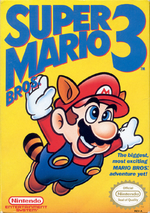
|
Another two years had passed by the time the next mainstream, non-port Mario game had been released: Super Mario Bros. 3. This was by far the most expansive Mario game on the NES, as it featured many levels, items, and enemies, and became a huge critical and commercial success. Many of the new species would become staples of the series, including Boos, Fire Piranha Plants and Dry Bones. In the story, Bowser and his seven Koopalings wreaked havoc across the Mushroom World after turning all of the Mushroom Kings into various animals. Mario and Luigi had to traverse through many worlds, castles, seas, forests, and deserts to fix the wrongs the Koopalings had caused. Eventually, the brothers reached Bowser and defeated him, rescuing Princess Toadstool once again. | Template:Release |
| Tetris | ||
| Template:Release | ||
| Dr. Mario | ||

|
The first game in the Dr. Mario series; it was released for the NES and for the Game Boy in 1990. The game brought the basic concept of the series to the players' attention immediately, as they would start the game off having to reorganize falling vitamin capsules in order to eradicate viruses from the screen. Once all viruses has been eliminated, the player would move on to the next level. As the game progressed, each level rose in difficulty, providing more viruses for the player to eliminate and less space to maneuver the vitamin capsules in. Dr. Mario was ported and remade many times after its original release. | Template:Release |
| Nintendo World Championships 1990 | ||
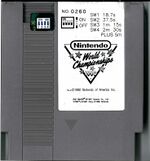
|
The NES cartridge serves as the primary competition in the 1990 Nintendo World Championship. The cartridge has a combination of Super Mario Bros., Rad Racer, and Tetris. The timer is set for 6 minutes and 21 seconds. Each game is modified for the contest, for example, Super Mario Bros. has been modified to make the game start with 99 lives instead of just 3. | Template:Release |
| Nintendo Campus Challenge | ||

|
Template:Release | |
| NES Open Tournament Golf | ||

|
This NES game was made in both America and Japan, featuring Mario, Luigi, Princess Toadstool, and Princess Daisy. Also, various other humans made their appearance, including Steve (beginner), Mark (amateur), Tony (semi-professional), and Billy (professional). In the American version, the graphics differ slightly, and the soundtrack has been changed. | Template:Release |
| Yoshi | ||
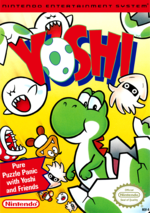
|
The first Yoshi game, simply called Yoshi, is a two-dimensional puzzle game, with elements similar to those of Tetris. The rules are fairly basic: the player must stack the same enemies on top of each other to make them disappear; the more the player does this, the more points they earn. | Template:Release |
| Yoshi's Cookie | ||
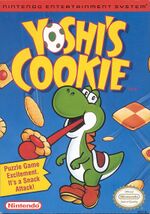
|
Just as Yoshi did, Yoshi's Cookie used many of the same elements found in Tetris. In order for the player to earn points and clear a stage, they have to have an entire row or column of the same type of cookie lined up. Six type of cookies could be found in the game: Heart Cookies, Sunflower Cookies, Green Cookies, Checkered Cookies, Donut Cookies, and Yoshi Cookies. A remake later appeared in Nintendo Puzzle Collection on the Nintendo GameCube, along with Dr. Mario and Panel De Pon. | Template:Release |
| Mario is Missing! | ||
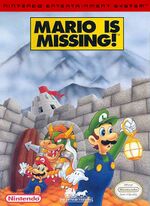
|
Mario is Missing! is a game that centers on Luigi as he tries to rescue Mario from Bowser by interacting with people and returning artifacts to their proper locations. | Template:Release |
| Wario's Woods | ||
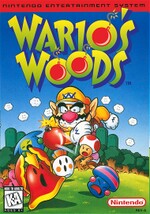
|
Wario's Woods is a puzzle game released for both the NES and SNES in 1994. The NES version was the last officially licensed game released for its console in North America and was the only game in its library to have an official rating by the ESRB. Wario's Woods is a falling block game where the objective is to clear the playing field of monsters by using bombs, arranging them into rows of matching colors. Unlike other puzzle games such as Tetris, where the player directly manipulates the game pieces, the player controls Toad, who moves around the playing field and arranges them after they have fallen. | Template:Release |
| Mario's Time Machine | ||
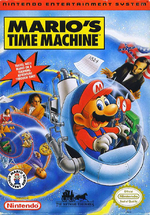
|
Mario's Time Machine is a game that centers on Mario as he tries to return various artifacts that were stolen by Bowser by interacting with people and answering various history-related questions. | Template:Release |
Family Computer Disk System
| Title | ||
|---|---|---|
| Cover | Synopsis | Release Date |
| Golf | ||
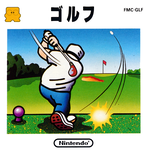
|
Template:Release | |
| Super Mario Bros. | ||
| On September 13, 1985, Mario starred in his very first game on a home console, Super Mario Bros.. Mario, and his brother Luigi, had to set out on a massive adventure across the Mushroom Kingdom to rescue Princess Toadstool and the Mushroom Retainers from the evil King Bowser. After traversing through eight massive worlds, filled with enemies, the brothers eventually reached Bowser's Castle, finally rescuing Princess Toadstool. Super Mario Bros. was the best-selling video game for the NES in 1999,[2] and, until being surpassed by Wii Sports in 2009, the best-selling video game of all time. Super Mario Bros. also had a major part in both the takeoff of the NES and the revival of the American video game industry after the crash in 1983. The game earned Mario a permanent position as Nintendo's mascot, and triggered a massive boom in the video game industry that still continues today. | Template:Release | |
| Super Mario Bros.: The Lost Levels | ||
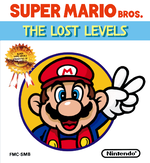
|
After the success of Super Mario Bros., a sequel was released just one year later in Japan for the Family Computer Disk System. It uses a slightly altered version of Super Mario Bros.'s engine, with different levels and new features including altered graphics and new enemy behavior, such as Bloopers flying in midair, wind to help the player jump across pits, and other minor changes.
While it was called Super Mario Bros. 2 in Japanese, Nintendo of America originally deemed this game too challenging and too much like the original to sell well in Western countries[3]. Instead, another game was ported as Super Mario Bros. 2, and the Japanese Super Mario Bros. 2 became known as Super Mario Bros.: The Lost Levels when included in the Super Mario All-Stars remake years later. It saw release in its original form in the West only when released on the Virtual Console in 2007. |
Template:Release |
| All Night Nippon Super Mario Bros. | ||

|
All Night Nippon Super Mario Bros. is an officially licensed hack of Super Mario Bros.: The Lost Levels. Gameplay is the same, but many characters such as the Mushroom Retainers are replaced with Japanese celebrities from the radio show All Night Nippon. Other changes are also made for this game, such as World 1 being set during nighttime and Princess Peach's outfit was changed. The game was only released in Japan. | Template:Release |
| Family Computer Golf: Japan Course | ||

|
This Japan-only game is a simple update to the 1984 original, although Mario is in his normal outfit. Luigi is available for the second player. There is also a palette-swapped computer opponent that wears black and brown.
Japan Course was involved in a major contest. After finishing all the holes, players had an option of saving their score. If the score was good, the score could be recorded into a special blue disk that came with the game and sent via Disk Fax to Nintendo in Kyoto. The top 100 scorers received a plaque with their names on it, as well as a golden Disk Card with their name and rank programmed onto the title screen and it contains a harder golf course called the Champions' Course. 5000 other contestants received the Professional Course golden Disk Card which is not as difficult as the Champions' Course but still much harder than the original. |
Template:Release |
| Family Computer Golf: Japan Course (Champions' Course) | ||
| Template:Release | ||
| Family Computer Golf: Japan Course (Professional Course) | ||
| Template:Release | ||
| Family Computer Golf: U.S. Course | ||

|
U.S. Course was released months later and is also a Japan-exclusive game. It is more open, and a bird's-eye-view of the holes is not available during gameplay, making it a bit more challenging. In this game, Mario wears a blue shirt and red-and-white striped overalls. Luigi is not mentioned in the game or the instruction manual but the second player is a green palette-swap while player 3 is blue and player 4 is orange. There is also a hidden female playable character that can be unlocked.
It also had a contest similar to Japan Course in which the main prize was a trophy and a golden Punch-Out!! Famicom cartridge. An unannounced prize was the golden disk Family Computer Golf: Prize Card which contained the harder Special Course. It was given out during the same contest but likely as part of a lottery to a thousand players whose submissions included a hole-in-one. |
Template:Release |
| Yume Kōjō: Doki Doki Panic | ||
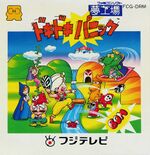
|
Yume Kōjō: Doki Doki Panic started development as a vertically scrolling Super Mario Bros.-style game, eventually gaining horizontal scrolling as well to be more similar. Due to a licensing agreement with Fuji Television, it starred a family of Arabian characters owned by the network. This game would go on to become the western Super Mario Bros. 2, with the Arabian characters replaced with Mario and friends, though other characters (namely enemies and bosses) remaining; many would become recurring to the series. | Template:Release |
| Family Computer Golf: Prize Card | ||
| Template:Release | ||
| Famicom Grand Prix: F1 Race | ||
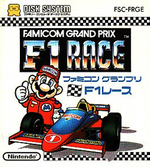
|
Template:Release | |
| Donkey Kong | ||
| In 1981, Nintendo had their first blockbuster release with Shigeru Miyamoto's creation - Donkey Kong. Originally released in the arcades, Donkey Kong became a very popular game amongst gamers, eventually spawning many remakes and ports. In this game, Donkey Kong was the antagonist who kidnapped Mario's girlfriend Lady (later renamed Pauline). It was later ported to the many home systems including the Atari 2600, the ColecoVision and the Nintendo Entertainment System. This is a simple platformer, where the player must control Mario while jumping and avoiding obstacles and making it to Donkey Kong. | Template:Release | |
| Famicom Grand Prix II: 3D Hot Rally | ||
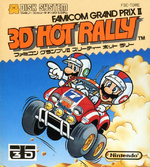
|
Template:Release | |
| Donkey Kong Jr. | ||
| In 1982, another arcade game was created, Donkey Kong Jr. This time, the roles were reversed. Mario was the villain, and DK was a damsel in distress. Here, Donkey Kong Jr., Donkey Kong's son, had to save his kidnapped father from Mario. The gameplay is the same as the original Donkey Kong; Donkey Kong Jr. must avoid traps set off by Mario to save Donkey Kong by jumping and simply avoiding them. | Template:Release | |
| Kaettekita Mario Bros. | ||
| File:Kaettekita Mario Bros. possible boxart.jpg | Kaettekita Mario Bros. is a Japan-only game for the Family Computer Disk System, being mostly a more graphically accurate port of the original arcade game than the 1983 Family Computer and Nintendo Entertainment System port. However, it also has new features, such as the ability to change direction mid-jump and a slot machine minigame. Many of its graphical enhancements were used in a 1993 European NES port of Mario Bros. | Template:Release |
| Wrecking Crew | ||
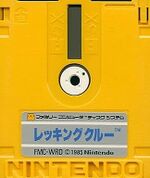
|
Wrecking Crew is a home variation of VS. Wrecking Crew, being more puzzle-oriented and based around single-player gameplay. Unlike in the previous game, the hammer-wielding CPU-controlled opponent is the brothers' cantankerous boss, Foreman Spike. This is the first Mario game to feature scrolling, albeit vertical scrolling. | Template:Release |
| Pinball | ||
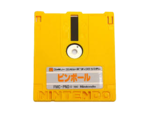
|
Template:Release | |